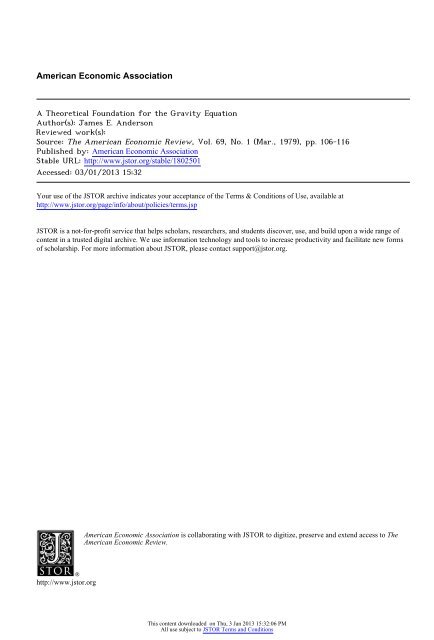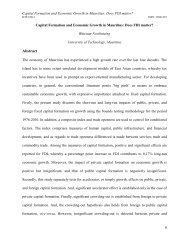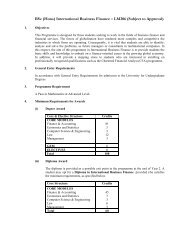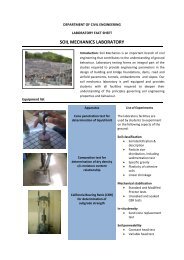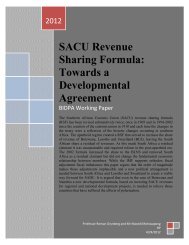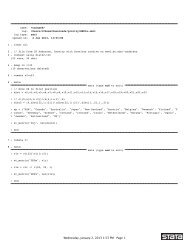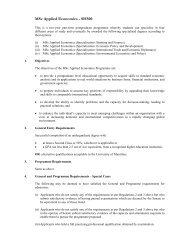A Theoretical Foundation for the Gravity Equation
A Theoretical Foundation for the Gravity Equation
A Theoretical Foundation for the Gravity Equation
You also want an ePaper? Increase the reach of your titles
YUMPU automatically turns print PDFs into web optimized ePapers that Google loves.
American Economic Association<br />
A <strong>Theoretical</strong> <strong>Foundation</strong> <strong>for</strong> <strong>the</strong> <strong>Gravity</strong> <strong>Equation</strong><br />
Author(s): James E. Anderson<br />
Reviewed work(s):<br />
Source: The American Economic Review, Vol. 69, No. 1 (Mar., 1979), pp. 106-116<br />
Published by: American Economic Association<br />
Stable URL: http://www.jstor.org/stable/1802501 .<br />
Accessed: 03/01/2013 15:32<br />
Your use of <strong>the</strong> JSTOR archive indicates your acceptance of <strong>the</strong> Terms & Conditions of Use, available at .<br />
http://www.jstor.org/page/info/about/policies/terms.jsp<br />
.<br />
JSTOR is a not-<strong>for</strong>-profit service that helps scholars, researchers, and students discover, use, and build upon a wide range of<br />
content in a trusted digital archive. We use in<strong>for</strong>mation technology and tools to increase productivity and facilitate new <strong>for</strong>ms<br />
of scholarship. For more in<strong>for</strong>mation about JSTOR, please contact support@jstor.org.<br />
.<br />
American Economic Association is collaborating with JSTOR to digitize, preserve and extend access to The<br />
American Economic Review.<br />
http://www.jstor.org<br />
This content downloaded on Thu, 3 Jan 2013 15:32:06 PM<br />
All use subject to JSTOR Terms and Conditions
A <strong>Theoretical</strong> <strong>Foundation</strong> <strong>for</strong> <strong>the</strong> <strong>Gravity</strong> <strong>Equation</strong><br />
By JAMES<br />
E. ANDERSON*<br />
Probably <strong>the</strong> most successful empirical<br />
trade device of <strong>the</strong> last twenty-five years is<br />
<strong>the</strong> gravity equation. Applied to a wide<br />
variety of goods and factors moving over<br />
regional and national borders under differing<br />
circumstances, it usually produces a<br />
good fit. Un<strong>for</strong>tunately, as is widely recognized,<br />
its use <strong>for</strong> policy is severely hampered<br />
by its "unidentified" properties.<br />
Insertion into <strong>the</strong> equation of policy instruments<br />
such as border taxes has no<br />
<strong>the</strong>oretical justification; and inference<br />
about <strong>the</strong> effect of taxes from examining<br />
changes in <strong>the</strong> equation over times when<br />
taxes have changed carries no guarantee of<br />
validity.<br />
The gravity equation ordinarily is specified<br />
as<br />
(1) Mijk = ak YI k y7kN kNjkd A,k Uijk<br />
where Mijk is <strong>the</strong> dollar flow of good or<br />
factor k from country or region i to country<br />
or region j, Yi and Yj are incomes in i and j,<br />
Ni and Nj are population in i and j, and d1j<br />
is <strong>the</strong> distance between countries (regions)<br />
i andj. The Uijk is a lognormally distributed<br />
error term with E(In Uijk) = 0. Frequently<br />
<strong>the</strong> flows are aggregated across goods.<br />
Ordinarily <strong>the</strong> equation is run on crosssection<br />
data and sometimes on pooled data.<br />
Typical estimates find income elasticities<br />
not significantly different from one and<br />
significantly different from zero, and population<br />
elasticities around -.4 usually significantly<br />
different from zero.'<br />
The intent of this paper is to provide a<br />
<strong>the</strong>oretical explanation <strong>for</strong> <strong>the</strong> gravity<br />
equation applied to commodities. It uses<br />
<strong>the</strong> properties of expenditure systems with<br />
a maintained hypo<strong>the</strong>sis of identical homo<strong>the</strong>tic<br />
preferences across regions. Products<br />
are differentiated by place of origin (<strong>for</strong><br />
*Professor of economics, Boston College. I am indebted<br />
to Marvin Kraus and Edward Leamer <strong>for</strong><br />
helpful comments.<br />
1 See <strong>for</strong> example Norman D. Aitken.<br />
106<br />
a justification, see Peter Isard). The gravity<br />
model constrains <strong>the</strong> pure expenditure system<br />
by specifying that <strong>the</strong> share of national<br />
expenditure accounted <strong>for</strong> by spending<br />
on tradeables (openness to trade) is a<br />
stable unidentified reduced-<strong>for</strong>m function<br />
of income and population. The share of<br />
total tradeable goods expenditure accounted<br />
<strong>for</strong> by each tradeable good category<br />
across regions is an identified (through<br />
preferences) function of transit cost variables.<br />
Partial identification is achieved.<br />
While o<strong>the</strong>r interpretations are possible<br />
(see <strong>for</strong> example Edward Leamer and<br />
Robert Stern),2 <strong>the</strong> one advanced here has<br />
2They offer three explanations. The first, based on<br />
physics, has little interest. The second identifies <strong>the</strong><br />
equation loosely as a reduced <strong>for</strong>m with exogenous<br />
demand-side variables (importer income and population)<br />
and supply-side variables (exporter income and<br />
population). Alternatively, <strong>the</strong> importer and exporter<br />
characteristics identify <strong>the</strong> size of <strong>the</strong> <strong>for</strong>eign<br />
sector in each, with any flow a function of size at ei<strong>the</strong>r<br />
end. The third interpretation is based on a probability<br />
model. Let Zi be country i's total imports, an unidentified<br />
reduced-<strong>for</strong>m function of income, population,<br />
and o<strong>the</strong>r possibly unobservable variables. The set<br />
IZil/T, where T = ,Z,, world trade, has <strong>the</strong> <strong>for</strong>m of<br />
a probability distribution. Alternatively Zi/T is a<br />
trade potential. The probability of <strong>the</strong> occurrence of<br />
flow between i and j is taken to be ZiZj/T2. Alternatively,<br />
potential between i and ] is <strong>the</strong> product of <strong>the</strong> i<br />
and j potentials. The expected size of <strong>the</strong> flow given<br />
T is <strong>the</strong>n Mii<br />
= ZiZj/T. The term T is constant in a<br />
cross-section study and can be neglected. Resistance<br />
to trade, proxied by distance, can be inserted and with<br />
<strong>the</strong> log-linear <strong>for</strong>m <strong>for</strong> all functions, we have <strong>the</strong><br />
gravity equation. This interpretation has <strong>the</strong> advantage<br />
of explaining <strong>the</strong> multiplicative functional <strong>for</strong>m, and<br />
has a useful flexibility. Leamer subsequently developed<br />
a hybrid version of it to explain aggregate imports of<br />
good k by country i. In <strong>the</strong> hybrid model, Zj becomes<br />
Zj(i) = 2jsiZj. Also, <strong>the</strong> parameters of <strong>the</strong> Zi and<br />
Zj(i) functions are permitted to vary by commodity<br />
group k. Leamer's hybrid is thus<br />
M1k = Zi Zj(i) 'I(di, ti, tj(j))<br />
where di is a vector of distance from i to all o<strong>the</strong>r<br />
countries, ti is a vector of i's tariffs, and tj(i) is a vector<br />
of all o<strong>the</strong>r countries' tariffs. The problem with<br />
ei<strong>the</strong>r <strong>the</strong> Leamer-Stern gravity interpretation or <strong>the</strong><br />
Leamer hybrid is that while <strong>the</strong> potential or probabil-<br />
This content downloaded on Thu, 3 Jan 2013 15:32:06 PM<br />
All use subject to JSTOR Terms and Conditions
VOL. 69 NO. I ANDERSON: GRA VITY EQUA TION 107<br />
four distinct advantages. First, it explains<br />
<strong>the</strong> multiplicative <strong>for</strong>m of <strong>the</strong> equation.<br />
Second, it permits an interpretation of distance<br />
in <strong>the</strong> equation, identifying <strong>the</strong> estimated<br />
coefficient, and can be used as part<br />
of an attack on estimating <strong>the</strong> effect of<br />
instrument changes. Third, <strong>the</strong> vague<br />
underlying assumption of identical "structure"<br />
across regions or countries is straight<strong>for</strong>wardly<br />
interpreted as identical expenditure<br />
functions. This suggests appropriate<br />
disaggregation. Finally, following <strong>the</strong> logic<br />
of <strong>the</strong> present interpretation implies that<br />
<strong>the</strong> usual estimator of <strong>the</strong> gravity equation<br />
may be biased, requiring change in <strong>the</strong><br />
method of estimation.<br />
The present interpretation of <strong>the</strong> gravity<br />
model makes it part of an alternative<br />
method of doing cross-section budget<br />
studies. The bias problems now uncovered<br />
may be quite severe, especially with transit<br />
costs varying considerably, but <strong>the</strong>re are<br />
efficiency gains to trade off against <strong>the</strong>m.<br />
The background of difficulty in modelling<br />
trade flows requires respect <strong>for</strong> any potentially<br />
promising method. This paper<br />
shows that <strong>the</strong> gravity model may merit<br />
continued development and use.<br />
Section I develops <strong>the</strong> simplest linear<br />
expenditure model, which produces an<br />
equation like (1) but with <strong>the</strong> last three<br />
variables omitted and with Yi and Yj constrained<br />
to have unit elasticity. The major<br />
portion of <strong>the</strong> explanatory power of <strong>the</strong><br />
gravity model is thus encompassed. While<br />
yielding a gravity equation, <strong>the</strong> models<br />
would never sensibly be so estimated.<br />
In <strong>the</strong> next two sections, <strong>the</strong> gravity approach<br />
gains legitimacy as a device offering<br />
large gains in efficiency of estimation at a<br />
possible cost of bias. An important fact of<br />
life is large interregional and international<br />
variations in shares of total expenditure<br />
accounted <strong>for</strong> by traded goods, even across<br />
regions or countries where spending patterns<br />
are reasonably similar (<strong>for</strong> example,<br />
<strong>the</strong> set of developed Western countries).<br />
These are assumed to vary as a function of<br />
ity story is plausible, it lacks a compelling economic<br />
justification.<br />
national income and population. Total<br />
trade expenditure is distributed across<br />
individual categories by share functions<br />
which are identical across countries. With<br />
this structure, Section II produces a gravity<br />
equation with potentially attractive properties.<br />
Section III discusses estimation of<br />
<strong>the</strong> model, shows that <strong>the</strong> usual technique<br />
may produce biased results, and suggests<br />
alternatives. Section IV integrates in distance<br />
(as a proxy <strong>for</strong> transport costs) and<br />
border taxes producing a full model suggesting<br />
<strong>the</strong> possibility of identifying longrun<br />
tariff elasticities. A constant elasticity<br />
of substitution (CES) case developed in <strong>the</strong><br />
Appendix provides fur<strong>the</strong>r details.<br />
Two areas <strong>for</strong> <strong>the</strong>oretical development<br />
may be noted. The major remaining unidentified<br />
part of <strong>the</strong> equation is <strong>the</strong> function<br />
stipulating that trade's share of<br />
budgets is dependent on income and<br />
population. While this is a well-established<br />
empirical relation, it would be nice to have<br />
an explanation. None is offered here.<br />
Use of pooled cross-section and timeseries<br />
data requires a fur<strong>the</strong>r development<br />
of <strong>the</strong> model also not attempted here. Two<br />
requirements should be noted. First, a<br />
<strong>the</strong>ory of how short-run responses to price<br />
changes (revealed over time) are related to<br />
long-run responses (revealed over <strong>the</strong> cross<br />
section) is needed. Second, a <strong>the</strong>ory of how<br />
short-run responses to income changes (revealed<br />
over time in <strong>the</strong> Keynesian type of<br />
trade model) are related to long-run responses<br />
must be constructed. Part of <strong>the</strong><br />
second story must be <strong>the</strong> relation of trade<br />
balance to asset accumulation stressed in<br />
<strong>the</strong> recent monetary approach to <strong>the</strong> balance<br />
of payments.<br />
I. The Pure Expenditure System Model<br />
The simplest possible gravity-type model<br />
stems from a rearrangement of a Cobb-<br />
Douglas expenditure system. Assume that<br />
each country is completely specialized in<br />
<strong>the</strong> production of its own good (as in a<br />
Keynesian-type trade model), so <strong>the</strong>re is<br />
one good <strong>for</strong> each country. No tariffs or<br />
transport costs exist. The fraction of income<br />
spent on <strong>the</strong> product of country i is<br />
This content downloaded on Thu, 3 Jan 2013 15:32:06 PM<br />
All use subject to JSTOR Terms and Conditions
108 THE AMERICAN ECONOMIC REVIEW MARCH 1979<br />
denoted bi and is <strong>the</strong> same in all countries<br />
(i.e., <strong>the</strong>re are identical Cobb-Douglas<br />
preferences everywhere). With cross-section<br />
analysis, prices are constant at equilibrium<br />
values and units are chosen such that <strong>the</strong>y<br />
are all unity. Consumption in value and<br />
quantity terms of good i in country j (= imports<br />
of good i by countryj) is thus<br />
(2) Mii = biYj<br />
where Yj is income in countryj.<br />
The requirement that income must equal<br />
sales implies that<br />
(3) Yi = bi(2 Y1)<br />
Solving (3) <strong>for</strong> bi and substituting into (2),<br />
we obtain<br />
(4) Mu = Yi Yj/2 Yj<br />
This is <strong>the</strong> simplest <strong>for</strong>m of "gravity"<br />
model. If we disregard error structure,3 a<br />
generalization of equation (4) can be estimated<br />
by ordinary least squares, with exponents<br />
on Yi, Yj unrestricted. In a pure<br />
cross section, <strong>the</strong> denominator is an irrelevant<br />
scale term. The income elasticities<br />
produced (disregarding bias) should not<br />
differ significantly from unity. The functional<br />
<strong>for</strong>m of <strong>the</strong> gravity equation and a<br />
major portion of <strong>the</strong> explanatory power is<br />
encompassed by <strong>the</strong> expenditure system<br />
model.<br />
II. The Trade-Share-Expenditure<br />
System Model<br />
The gravity equation of Section I is based<br />
on identical Cobb-Douglas preferences,<br />
implying identical expenditure shares and<br />
gravity equation income elasticities of<br />
unity. It could be fancied up by allowing<br />
policy induced price differences to produce<br />
different expenditure shares in a less restrictive<br />
preference <strong>for</strong>m such as <strong>the</strong> CES, but<br />
<strong>the</strong>re is little point in <strong>the</strong> exercise. While<br />
a gravity equation is produced by such a<br />
3Note that <strong>the</strong> manipulation which justified <strong>the</strong><br />
presence of Yi in (4) means that <strong>the</strong>re may be simultaneous<br />
equation bias, with <strong>the</strong> Y's not being independent<br />
of error terms postulated <strong>for</strong> <strong>the</strong> equations (2)<br />
and (3). This problem is discussed in Section III.<br />
framework, <strong>the</strong> real variables of interest<br />
are <strong>the</strong> non-income-dependent expenditure<br />
shares. The gravity equation is a silly specification<br />
from an econometric standpoint<br />
since it substitutes out <strong>the</strong> share (which in<br />
<strong>the</strong> Cobb-Douglas case is <strong>the</strong> only parameter).<br />
This section appends to <strong>the</strong> Cobb-<br />
Douglas expenditure system <strong>for</strong> traded<br />
goods a differing traded-nontraded goods<br />
split and produces an unrestricted (nonunit<br />
income elasticity) gravity equation.<br />
The next section shows that <strong>the</strong> gravity<br />
equation becomes far more sensible.<br />
Traded-goods shares of total expenditure<br />
vary widely across regions and countries.<br />
Hollis Chenery and o<strong>the</strong>rs subsequently<br />
have found that in cross-section data such<br />
shares are "explained" ra<strong>the</strong>r well by income<br />
and population. Moreover, <strong>the</strong> linear or<br />
log-linear regression line of traded goods<br />
shares on income and population tends to<br />
be stable over time. No identification of this<br />
relationship is attempted here, but loosely,<br />
income per capita is an exogenous demandside<br />
factor, and population (country size)<br />
a supply-side factor. Trade shares "should"<br />
increase with income per capita and decrease<br />
with size. Leamer and Stern have<br />
also suggested including an endowment<br />
measure as an explanatory variable which<br />
would act somewhat like size.4 Accepting<br />
<strong>the</strong> stability of <strong>the</strong> trade-share function,<br />
<strong>the</strong> expenditure system model combines<br />
with it to produce <strong>the</strong> gravity equation.<br />
Assume that all countries produce a<br />
traded and a nontraded good. The overall<br />
preference function assumed in this <strong>for</strong>mu-<br />
41t is easy to construct examples where <strong>the</strong> trade<br />
share is a simple closed <strong>for</strong>m function of factor endowment<br />
variables. Consider <strong>the</strong> small-country case in<br />
which all traded goods may be treated as a composite<br />
and <strong>the</strong>re is one nontraded good. Stipulate a simple<br />
non-Cobb-Douglas utility function in traded goods<br />
and <strong>the</strong> nontraded good and assume <strong>the</strong> linear version<br />
of <strong>the</strong> two-sector production model. When a model<br />
of this sort is solved <strong>for</strong> an interior equilibriumtraded-goods<br />
share assuming trade balance, it produces<br />
a relatively simple function of <strong>the</strong> endowments.<br />
Results analogous to <strong>the</strong> Johnson pro- and antitrade<br />
bias analysis are embodied in <strong>the</strong> function. I have<br />
been unable, however, to discover a specification<br />
which produces a traded-goods share function which<br />
is log-linear in income and factor endowments.<br />
This content downloaded on Thu, 3 Jan 2013 15:32:06 PM<br />
All use subject to JSTOR Terms and Conditions
VOL. 69 NO. I ANDERSON: GRA VITY EQUA TION 109<br />
lation is weakly separable with respect to<br />
<strong>the</strong> partition between traded and nontraded<br />
goods: u = u (g(traded goods), nontraded<br />
goods). Then given <strong>the</strong> level of expenditure<br />
on traded goods, individual traded-goods<br />
demands are determined as if a homo<strong>the</strong>tic<br />
utility function in traded goods alone g( )<br />
were maximized subject to a budget constraint<br />
involving <strong>the</strong> level of expenditure<br />
on traded goods. The individual tradedgoods<br />
shares of total trade expenditure<br />
with homo<strong>the</strong>ticity are functions of tradedgoods<br />
prices only.5 For simplicity, it is<br />
assumed g( ) has <strong>the</strong> Cobb-Douglas <strong>for</strong>m<br />
in <strong>the</strong> rest of <strong>the</strong> text. Within <strong>the</strong> class of<br />
traded goods, since preferences are identical,<br />
expenditure shares <strong>for</strong> any good are<br />
identical across countries. Thus, <strong>for</strong> any<br />
consuming country j, 0i is <strong>the</strong> expenditure<br />
on country i's tradeable good divided by<br />
total expenditure in j on tradeables; i.e.,<br />
Oi is an exponent of g( ). Let /j be <strong>the</strong><br />
share of expenditure on all traded goods in<br />
total expenditure of country j and 4j =<br />
F( Yj, Nj).<br />
Demand <strong>for</strong> i's tradeable good in countryj<br />
(j's imports of i's good) is<br />
(5) Mij = "i Yj<br />
The balance-of-trade relation <strong>for</strong> country<br />
i implies<br />
(6) Yii= (Yjoj)0i<br />
value of imports of i<br />
plus domestic spending =<br />
on domestic tradeables<br />
value of exports of i<br />
plus domestic spending<br />
on domestic tradeables<br />
5Homo<strong>the</strong>ticity of g( ) is imposed because <strong>the</strong><br />
presence of traded-goods expenditure as an argument<br />
in <strong>the</strong> Oi function will greatly complicate estimation.<br />
Separability is imposed to permit <strong>the</strong> two-stage decision<br />
process which removes nontraded-goods prices<br />
from <strong>the</strong> 0i function. Some justification <strong>for</strong> separability<br />
may be found in <strong>the</strong> observation that traded goods<br />
are far more similar to each o<strong>the</strong>r than <strong>the</strong>y are to<br />
nontraded goods. Homo<strong>the</strong>ticity would imply that,<br />
ceteris paribus, larger nations' trade expenditures are<br />
scalar expansions of smaller nations' trade expenditures.<br />
This may not do great violence to reality. A<br />
gravity-type model which imposes nei<strong>the</strong>r restriction is<br />
possible, but it would be far more complex and difficult<br />
to estimate. As with most empirical work on<br />
preferences, <strong>the</strong> restrictions' main appeal is convenience.<br />
Solving (6) <strong>for</strong> 0i and substituting into (5),<br />
we have<br />
Y<br />
q7)<br />
yi j Xi<br />
(7) M1= =<br />
YiJi Yi<br />
, ,, E Xji yi E mii<br />
j<br />
iij<br />
With F(Yi, N1) taking on a log-linear <strong>for</strong>m,<br />
(7) is <strong>the</strong> deterministic <strong>for</strong>m of <strong>the</strong> gravity<br />
equation (1) with <strong>the</strong> distance term suppressed<br />
and a scale term appended. More<br />
realistically, if trade imbalance due to longterm<br />
capital account transactions is a function<br />
of (Yi, N1), we may write <strong>the</strong> "basic"<br />
balance Yiimi = (2jY,j)0, with mi =<br />
m(Yi, Ne), and substitute into (6) and (7).<br />
This yields6<br />
(8) M1j = mA5 Yij Yj<br />
With log-linear <strong>for</strong>ms <strong>for</strong> m and F, (8) is<br />
again essentially <strong>the</strong> deterministic gravity<br />
equation.<br />
III. Estimation Efficiency<br />
The model of linear expenditures of Section<br />
I, while implying a gravity equation,<br />
would never sensibly be so estimated.<br />
Homo<strong>the</strong>tic preferences identical across<br />
countries imply identical expenditure share<br />
functions, and <strong>the</strong>se can be estimated directly,<br />
treating distance and trade taxes appropriately<br />
in a manner set out in Section<br />
IV. Simply divide <strong>the</strong> demand equations of<br />
Section I or <strong>the</strong>ir analogue by own income<br />
and find <strong>the</strong> mean over j of Mi,/ Yj = <strong>the</strong><br />
estimator of Oi. The stochastic budget constraint<br />
in<strong>for</strong>mation can also be utilized to<br />
(in effect) add one observation since7 0i =<br />
yi/Ij Yj.<br />
The trade-share model of Section II on<br />
<strong>the</strong> o<strong>the</strong>r hand lends some legitimacy to <strong>the</strong><br />
gravity model. Eventually we will allow<br />
6Balance-of-payments disequilibrium could be<br />
treated as part of <strong>the</strong> error terms in estimation. Use<br />
of <strong>the</strong> model is best restricted to equilibrium years,<br />
however, since error terms due to disequilibrium may<br />
be correlated with Y,, Nj, and <strong>the</strong>re<strong>for</strong>e cause errors<br />
in estimation.<br />
7Again, we disregard <strong>the</strong> problem that <strong>the</strong> Y's depend<br />
on <strong>the</strong> error term through <strong>the</strong> budget constraint.<br />
i<br />
i<br />
This content downloaded on Thu, 3 Jan 2013 15:32:06 PM<br />
All use subject to JSTOR Terms and Conditions
110 THE AMERICAN ECONOMIC REVIEW MARCH 1979<br />
many tradeables <strong>for</strong> each country, with<br />
tariffs and transport costs present, but initially,<br />
as be<strong>for</strong>e, assume only one tradeable<br />
in each and no barriers to trade. The system<br />
to be estimated is<br />
(5') M = Oj0 Yj Uj,<br />
(6') m1i bY, = Oi 01Yi<br />
i<br />
where Uii is a log-normal disturbance with<br />
E(/n Uij) = 0. Note that (6') states that<br />
planned expenditures (reduced or increased<br />
by <strong>the</strong> capital account factor) = planned<br />
sales, and has no error term. Efficient estimation<br />
requires that <strong>the</strong> in<strong>for</strong>mation in (6')<br />
be utilized. The most convenient way to do<br />
this, since <strong>the</strong> constraint is highly nonlinear<br />
in <strong>the</strong> Y's, is to substitute out Oi and<br />
estimate <strong>the</strong> gravity equation:<br />
(8) M i =<br />
m(Yi, Ni)F(Yi, Nj YiF(Yj, Nj) Yj<br />
ZF(Yj,Nj)Y J<br />
With <strong>the</strong> log-linear <strong>for</strong>m <strong>for</strong> m( ) and F( ),<br />
and<br />
m(Yi, N) = km YTYNTN<br />
F(Yj,Nn) = k?,H': Nj<br />
and <strong>the</strong> denominator made a constant term<br />
we have<br />
(8') Mij = (km YYNy N )(kX Y/+YN/iN)Y<br />
* (k,l y+NjN) YjUij k'<br />
=<br />
(kmk,) Y+myY+' N7mN+'PN<br />
* OY + l<br />
YI N OfjN j Ui .k' k<br />
This is <strong>the</strong> aggregate <strong>for</strong>m of (1) with <strong>the</strong><br />
distance term omitted. Ordinarily it would<br />
be fitted on a subset of countries in <strong>the</strong><br />
world. Exports to <strong>the</strong> rest of <strong>the</strong> world are<br />
exogenous and imports from it are excluded<br />
from <strong>the</strong> fitting. When this is done, <strong>the</strong> denominator<br />
is still <strong>the</strong> sum of world trade<br />
expenditures, and (6') implies that (8) and<br />
(8') assume that Oi is <strong>the</strong> same in <strong>the</strong> excluded<br />
countries as in <strong>the</strong> included countries.<br />
Alternatively, (6') can be interpreted<br />
as a payments union multilateral balance<br />
constraint (which includes as a special case<br />
<strong>the</strong> rest of <strong>the</strong> world account being always<br />
zero). The denominator of (8) and (8') <strong>the</strong>n<br />
has only <strong>the</strong> included group's trade expenditure.8<br />
Under ei<strong>the</strong>r interpretation, <strong>the</strong><br />
identifying restrictions immediately allow<br />
recovery of all structural exponents from<br />
<strong>the</strong> estimator of (8'). Ei<strong>the</strong>r interpretation<br />
will also permit <strong>the</strong> complex constant term<br />
(km kl/k') to be unravelled, though <strong>the</strong><br />
estimators kmin kO<br />
, k' have only large sample<br />
unbiasedness.9 Finally, <strong>for</strong>m <strong>the</strong> set of estimated<br />
values <strong>for</strong> traded-goods expenditures:<br />
(9) fj Yj = k/ Yky+I NjN<br />
The individual traded-goods shares 0<br />
can be estimated using <strong>the</strong> instruments $^<br />
(which are asymptotically uncorrelated with<br />
Ujj):<br />
8If nei<strong>the</strong>r of <strong>the</strong>se alternatives is palatable, exports<br />
to <strong>the</strong> rest of <strong>the</strong> world can be fixed at Mi,n+ 1. Trade<br />
balance is now<br />
(a)<br />
miqi Yi = Oil k1 Y1 + Mi,n+ I<br />
I<br />
When <strong>the</strong> trade balance is solved <strong>for</strong> Qi and substituted,<br />
<strong>the</strong> gravity equation is<br />
(b) M (Mi0i Yi Min+ l) )?jYj<br />
Z ki i<br />
Non-linear methods must be used to estimate (b).<br />
9Consider <strong>the</strong> worldwide identity of preferences<br />
case. Using conditional expectations in (6'), <strong>the</strong> trade<br />
balance requirement implies that<br />
kmkl y l Yy+myN 4mN = E E(Mi) + M I<br />
1= 1<br />
where Mi,n+ I is <strong>the</strong> exogenous nonrandom export<br />
of i to <strong>the</strong> rest of <strong>the</strong> world. Replacing E(Mij) with its<br />
solved values M1j, and <strong>the</strong> exponents with <strong>the</strong>ir estimated<br />
values, we have<br />
(a)<br />
kmk= [Z ^1] i + Min - N i<br />
J= 1<br />
Using <strong>the</strong> definition of k', we have<br />
(b) k' = k,(Z YJ$YN $N) + E<br />
Finally <strong>the</strong> estimated constant term k, is <strong>the</strong>oretically<br />
related to <strong>the</strong> three constants km, k,0, k' by<br />
(c)<br />
k = kmk2/k'<br />
(a)-(c) can be solved explicitly <strong>for</strong> <strong>the</strong> three constants<br />
kmi ko, k'.<br />
This content downloaded on Thu, 3 Jan 2013 15:32:06 PM<br />
All use subject to JSTOR Terms and Conditions
VOL. 69 NO. I ANDERSON: GRA VITY EQUATION 111<br />
(10) Mij = ei j Yj Uij<br />
which is estimated across countries <strong>for</strong><br />
country i's exports (including <strong>the</strong> rest of <strong>the</strong><br />
world's exports to included countries), subject<br />
to <strong>the</strong> restriction that ZOi = 1. The alternative<br />
without <strong>the</strong> gravity model is to<br />
estimate <strong>the</strong> O's by regressing liMijI Yj on<br />
F( Yj, Nj) and <strong>the</strong>n repeating <strong>the</strong> second<br />
stage. The gravity equation in effect squares<br />
<strong>the</strong> number of observations used in estimating<br />
<strong>the</strong> parameters of F(Y, N). For <strong>the</strong><br />
limited number of cross-section observations<br />
available, <strong>the</strong> gain in efficiency should<br />
be large.<br />
It is ironic, however, that <strong>the</strong> very simultaneity<br />
which allows substitution <strong>for</strong> Oi<br />
may imply that <strong>the</strong> Y's are mutually determined<br />
with <strong>the</strong> error terms of <strong>the</strong> expenditure<br />
system. The model (5')-(6') postulates<br />
no random term in <strong>the</strong> trade balance constraint<br />
and thus allows treatment of <strong>the</strong> Y's<br />
as predetermined. Suppose alternatively<br />
that <strong>the</strong> trade balance constraint is a stochastic<br />
<strong>for</strong>m:<br />
(6") mi(Z M}i) = L Mi1<br />
I<br />
i<br />
or mii Y '(ZjOUji) = 0i(Eqj YjU,1)<br />
., I<br />
Then (8) becomes<br />
(8") M11 = tn,k,Y ikY<br />
where ij = Uij E OjUji /EZ U1i<br />
A regression based on (8") with m( ) and<br />
F( ) assigned <strong>the</strong> multiplicative <strong>for</strong>m will<br />
produce biased results (with unknown direction)<br />
due to <strong>the</strong> dependency of <strong>the</strong> Y's<br />
on <strong>the</strong> error terms. The relative stability of<br />
<strong>the</strong> equation over time in some applications<br />
may suggest that <strong>the</strong> bias is not serious, but<br />
this is conjectural. Several alternatives are<br />
possible, two of which will be discussed<br />
here. Something like <strong>the</strong> gravity equation<br />
would be desirable, replacing <strong>the</strong> Y's in<br />
<strong>the</strong> equation with <strong>the</strong> instruments highly<br />
correlated with <strong>the</strong> Y's but independent of<br />
<strong>the</strong> demand equation error terms. One such<br />
instrument might be lagged income, particularly<br />
<strong>for</strong> years when last year's income<br />
seems unlikely to be correlated with this<br />
year's error term. Bias remains, but may be<br />
reduced. The o<strong>the</strong>r alternative is to attempt<br />
dealing with simultaneity directly. Suppose<br />
a subset of countries is considered and<br />
preferences <strong>for</strong> traded goods are everywhere<br />
<strong>the</strong> same. Rest of <strong>the</strong> world demand is considered<br />
exogenous. Run <strong>the</strong> gravity equation<br />
using ordinary least squares on <strong>the</strong> log<br />
of <strong>the</strong> equation (or non-linear estimation of<br />
<strong>the</strong> equation with an additive disturbance<br />
term) and obtain estimates of Xi, 4,, and<br />
mi, mi; i= 1,..., n.'0 The trade balance<br />
equations in matrix notation are<br />
(11) (diag m)(diag 0) Y = (Lt') (diag 4)<br />
y + M.n+ I<br />
where M = rest of <strong>the</strong> world demand,<br />
an n x I vector<br />
Y = n x 1 vector of incomes<br />
(diag ?) = n x n diagonal matrix<br />
with 4y, i = I. n on <strong>the</strong><br />
diagonal<br />
o = n x I vector of O3i i =<br />
. ,, n<br />
Il = 1 x n row vector of ones<br />
(diag mr) = n x n diagonal matrix with<br />
i,, i = 1,..., n on <strong>the</strong><br />
diagonal<br />
or"' Y = (diag )-'[I - OL]IMn+l<br />
The left-hand side contains instruments <strong>for</strong><br />
<strong>the</strong> Y's which attempt to deal with <strong>the</strong><br />
simultaneity problem, and which can <strong>the</strong>n<br />
be inserted into <strong>the</strong> gravity equation and<br />
used to reestimate <strong>the</strong> W's, O's, and 0's.<br />
Continued iteration would have no necessarily<br />
desirable property.<br />
Ei<strong>the</strong>r instrument would probably be<br />
preferable if <strong>the</strong> simultaneity problem were<br />
severe, as in <strong>the</strong> European Economic Community<br />
(EEC). For groups of countries with<br />
10Since E(ln eij) s 0, previous methods of identifying<br />
km and kO, cannot be used. For simplicity, this detail<br />
can be evaded by assuming km = kO = 1.<br />
IIProvided 2jOi < 1, I - OL' has an inverse. We deal<br />
with a subset of goods and countries, so <strong>the</strong> condition<br />
is fulfilled. M., + I = e n + I Yn + l with <strong>the</strong> assumption<br />
of identical preferences <strong>for</strong> <strong>the</strong> rest of <strong>the</strong> world.<br />
This content downloaded on Thu, 3 Jan 2013 15:32:06 PM<br />
All use subject to JSTOR Terms and Conditions
112 THE AMERICAN ECONOMIC REVIEW MARCH 1979<br />
relatively small interdependence, <strong>the</strong> gravity<br />
equation with <strong>the</strong> Y's directly used might<br />
be preferable, <strong>the</strong> greater efficiency of direct<br />
use of Y's dominating <strong>the</strong> bias. These are,<br />
of course, only rules of thumb.'2<br />
IV. Many Goods, Tariffs, and Distance<br />
Now consider <strong>the</strong> gravity equation under<br />
<strong>the</strong> complication of many commodity classes<br />
of goods flowing between each country i<br />
andj, with a full set of national tariffs in<br />
each country, and with transport costs<br />
proxied by distance. Preferences <strong>for</strong> traded<br />
goods are identical across countries and are<br />
homo<strong>the</strong>tic, with <strong>the</strong> traded-goods share, as<br />
be<strong>for</strong>e, a function of income and population.<br />
Within each commodity class, goods<br />
are considered to be differentiated by place<br />
of origin.'3 The gravity equation still has<br />
use in <strong>the</strong> estimation of trade-flow equations<br />
of this system. As in Section 111, it is a<br />
device <strong>for</strong> increasing <strong>the</strong> efficiency of estimation<br />
of <strong>the</strong> trade-share function parameters.<br />
Un<strong>for</strong>tunately, tariffs and transport<br />
costs create added sources of bias in estimation<br />
of both stages. The gain may still<br />
outweigh <strong>the</strong> loss.<br />
The landed value at country j of commodity<br />
class k goods produced in country i<br />
is MijkTijk, where Mijk is <strong>the</strong> <strong>for</strong>eign port<br />
value and Tiyk is <strong>the</strong> transit cost factor (including<br />
all border adjustments and transport<br />
costs). With identical homo<strong>the</strong>tic<br />
preferences <strong>for</strong> traded goods, <strong>the</strong> tradedgoods<br />
expenditure shares are identical functions<br />
Oik (ri), where Tj is <strong>the</strong> vector of <strong>the</strong><br />
12We should note that in principle minimumdistance<br />
or full-in<strong>for</strong>mation maximum-likelihood<br />
techniques can be used to estimate <strong>the</strong> parameters of<br />
system (5')-(6') and its generalization. Any model<br />
which can be solved to isolate its disturbance terms<br />
can be so treated (see A. R. Gallant). The costliness<br />
and convergence difficulties with such non-linear techniques<br />
makes compromises like those in <strong>the</strong> text<br />
attractive.<br />
13Isard offers an empirical justification <strong>for</strong> this<br />
assumption. On a <strong>the</strong>oretical level, note that <strong>the</strong><br />
gravity model almost necessarily implies differentiation<br />
by place of origin. How else can (i) two-way flows<br />
be explained, and (ii) <strong>the</strong> flow of good k between<br />
points i and j be modelled as a function of variables<br />
at i and j alone?<br />
Tijk'S <strong>for</strong> country j. Demand <strong>for</strong> import ik<br />
(with <strong>for</strong>eign port prices of unity as be<strong>for</strong>e)<br />
is<br />
(12) Mijk = 1 ik (7i) i YJ<br />
Aggregate trade flows between i and j are<br />
thus<br />
(13) Mij = Mijk = Xj yj Oik(ri)<br />
k k Tijk<br />
The trade balance relation is<br />
(14) miiYi = EMi<br />
= z j Yz Oik (Tj)<br />
j k Tijk<br />
Previously we set all <strong>the</strong> Tijk = 1 and could<br />
divide both sides of (14) by 24jj Yj to obtain<br />
<strong>the</strong> aggregate share parameter <strong>for</strong> country i<br />
goods on <strong>the</strong> right: 2kOik. The left-hand<br />
side was <strong>the</strong>n substituted into (13) to obtain<br />
<strong>the</strong> gravity equation<br />
(8) M =Mi0iY<br />
Note that with many goods, only <strong>the</strong> aggregate<br />
version of <strong>the</strong> gravity equation is<br />
valid under <strong>the</strong> present interpretation. 14<br />
141Leamer has extended <strong>the</strong> gravity-type crosssection<br />
model to aggregation across partner countries<br />
j, estimating aggregate outward flows Mik. His model<br />
shares with <strong>the</strong> present interpretation unidentified<br />
reduced-<strong>for</strong>m trade potential functions similar to <strong>the</strong><br />
trade-share functions above. It is fur<strong>the</strong>r unidentified<br />
because Leamer gives no precise economic reason <strong>for</strong><br />
<strong>the</strong> appearance and <strong>for</strong>m of <strong>the</strong> appearance in <strong>the</strong><br />
equation of trade potential at both ends of <strong>the</strong> trade<br />
flow. Never<strong>the</strong>less, it has a certain plausibility and allows<br />
extension to <strong>the</strong> estimation of tariff elasticities.<br />
In correspondence concerning an earlier version of<br />
this paper, Leamer suggested a method of obtaining<br />
commodity-specific gravity equations not involving <strong>the</strong><br />
trade potential interpretation. As be<strong>for</strong>e, <strong>the</strong> demand<br />
function is<br />
(a) Mijk = Oikkj Y]<br />
Country i's income from sales of <strong>the</strong> ik good is<br />
(b) Yik = Oik E X Yi<br />
Suppose that <strong>the</strong> commodity classes k are defined so<br />
that income from <strong>the</strong>ir production across countries<br />
This content downloaded on Thu, 3 Jan 2013 15:32:06 PM<br />
All use subject to JSTOR Terms and Conditions
VOL. 69 NO. I ANDERSON: GRA VITY EQUA TION 113<br />
With <strong>the</strong> Tijk departing from unity <strong>the</strong><br />
division of both sides of (14) by 2j?j Yj produces<br />
(15) Y, -Z<br />
-O_ (r1)<br />
1: 4)Zjb1 k ik (j<br />
J<br />
i<br />
The gravity equation substitutes <strong>for</strong> <strong>the</strong><br />
share in (13), 1k(l1/Tik)0ik(Tj), a weighted<br />
average of such shares across all countries j.<br />
This will cause bias of unknown sign in <strong>the</strong><br />
gravity equation parameter estimator based<br />
on <strong>the</strong> stochastic version of (12)-(14), and<br />
subsequently in <strong>the</strong> parameter estimator of<br />
<strong>the</strong> demand equation (12).'5 O<strong>the</strong>r factors<br />
being equal, <strong>the</strong> bias will be less <strong>the</strong> more<br />
closely <strong>the</strong> transit costs resemble one ano<strong>the</strong>r.<br />
In <strong>the</strong> limit, we return to <strong>the</strong> model<br />
of Section III. Evidently, similarity of<br />
transit costs should be a criterion <strong>for</strong> selecting<br />
countries in <strong>the</strong> cross-section sample.<br />
This is too stringent a criterion to permit<br />
<strong>the</strong> viability of <strong>the</strong> gravity model and flies in<br />
<strong>the</strong> face of <strong>the</strong> role it assigns to distance. To<br />
brea<strong>the</strong> life back into it, we can argue that<br />
with dissimilarity of restricted types it may<br />
still be possible to escape with small bias.<br />
If transit costs of all sorts are an increasing<br />
function of distance and <strong>the</strong> same across<br />
commodities (T ik = f(dij) with f(O) = 1<br />
and f' > 0), <strong>the</strong>n with Cobb-Douglas<br />
preferences <strong>the</strong> demand equation and trade<br />
balance equations are<br />
is a stable function of GNP, population and resource<br />
endowments Ei:<br />
(c) Yik = 7k( Yit Ni, Ei) Yi<br />
Substituting (b) and (c) into (a) we obtain a gravity<br />
<strong>for</strong>m:<br />
(d) Mik =<br />
lyk( yit Nit Ei) Yioj( Yjt Njt Ej) Yj<br />
This may be a promising approach, although <strong>the</strong><br />
stability of <strong>the</strong> yk functions is probably more controversial<br />
than <strong>the</strong> stability of <strong>the</strong> kj functions.<br />
15The demand equation as be<strong>for</strong>e would be estimated<br />
using cj Yj as an instrument. Note that <strong>the</strong><br />
parameters to be estimated would in principle include<br />
substitution parameters.<br />
(13 ) Mij = (I 0uk)4JYJ U<br />
k f ~(d1i)<br />
(15') miOiYi = ( Eik) E Yj<br />
k j ~f(d1i)<br />
<strong>Equation</strong> (13') states that <strong>the</strong> <strong>for</strong>eign port<br />
value of country j's demand <strong>for</strong> all of i's<br />
goods equals country j's total expenditure<br />
on traded goods (in home prices), 4j Yj,<br />
times <strong>the</strong> common aggregate traded-goods<br />
expenditure share <strong>for</strong> i's goods 2:k ik deflated<br />
by <strong>the</strong> transit cost factor. <strong>Equation</strong><br />
(15') states that country i's expenditure on<br />
all traded goods at i's prices 4i Yi times <strong>the</strong><br />
capital account scale factor mi must equal<br />
<strong>the</strong> value at country i of i's exports to all<br />
countries. The gravity equation can now be<br />
derived as<br />
mi0ibYi0b1Y1 1<br />
(16) Mi. = m _ _ _____Y<br />
z yj f(dI)<br />
*<br />
E<br />
j yj f (dj)<br />
i<br />
With m and <strong>the</strong> ?'s made log-linear functions<br />
of income and population, (16) resembles<br />
(1), with three differences. First,<br />
(16) is an aggregate equation ra<strong>the</strong>r than<br />
commodity specific. Second, 1 /f (dij) is not<br />
a log-linear function.'6 Finally, <strong>the</strong> square<br />
bracket term is missing in (1). It can be<br />
interpreted as saying that <strong>the</strong> flow from i to<br />
j depends on economic distance from i to j<br />
relative to a trade-weighted average of<br />
economic distance from i to all points in <strong>the</strong><br />
system. The model leading to (16) is probably<br />
<strong>the</strong> best case one can tnake <strong>for</strong> <strong>the</strong> aggregate<br />
gravity equation as it is usually<br />
fitted in practice. The square bracket term<br />
might have little variation across origin<br />
points i <strong>for</strong> a group of countries distributed<br />
geographically in a polygon (<strong>for</strong> example,<br />
<strong>the</strong> EEC). Changing origin point i will<br />
leng<strong>the</strong>n some distances and shorten o<strong>the</strong>rs,<br />
with <strong>the</strong> potential <strong>for</strong> little change in <strong>the</strong><br />
weighted average. With small enough bias,<br />
16Practitioners of <strong>the</strong> gravity model use it only because<br />
it is so convenient, and some have adopted more<br />
<strong>the</strong>oretically appealing <strong>for</strong>ms.<br />
This content downloaded on Thu, 3 Jan 2013 15:32:06 PM<br />
All use subject to JSTOR Terms and Conditions
114 THE AMERICAN ECONOMIC REVIEW MARCH 1979<br />
<strong>the</strong> greater efficiency of <strong>the</strong> gravity equation<br />
(1) in aggregate <strong>for</strong>m in arriving at<br />
estimates of /jYj dominates,"7 and <strong>the</strong> O's<br />
can be estimated from<br />
( 12') Mijk = [(f) Y 0 ik LUijk<br />
If <strong>the</strong> bias from omitting <strong>the</strong> bracketed term<br />
is likely to be substantial, (16) can be estimated<br />
with constant weights in <strong>the</strong> bracket<br />
term equal to observed trade total expenditure<br />
shares. Non-linear least squares is required,<br />
implying some loss in efficiency.<br />
Which procedure is preferable depends on<br />
<strong>the</strong> tradeoff.<br />
Practitioners may be able to get away<br />
with restrictions less extreme than ei<strong>the</strong>r<br />
<strong>the</strong> identical transit costs or Cobb-Douglas<br />
asstumptions. Consider <strong>the</strong> CES preference<br />
case where trade taxes are <strong>the</strong> same across<br />
all countriesj <strong>for</strong> any good k of country i<br />
(often an assumption which comes close to<br />
reality, as in <strong>the</strong> EEC). Assume transport<br />
cost factors depend only on distance (not<br />
on commodity group). Under <strong>the</strong>se conditions,<br />
<strong>the</strong> Appendix shows that a gravity<br />
equation may still have some promise of<br />
providing efficiency gains which dominate<br />
bias. The CES demand functions may be<br />
estimated as above.in a second stage using<br />
<strong>the</strong> instrument 1j Yj. In principle, a trade<br />
17Disregarding bias, <strong>the</strong> procedure <strong>for</strong> solving out<br />
<strong>the</strong> parameters of <strong>the</strong> m( ) and F( ) functions are essentially<br />
<strong>the</strong> same as in Section II. The only new factor<br />
is <strong>the</strong> presence of f(dij). If we adopt <strong>the</strong> log-linear<br />
<strong>for</strong>m, (16) assures us that any constant term it possesses<br />
is cancelled out (i.e., if f (dij) = kddg'1, <strong>the</strong> kd<br />
term would not appear in <strong>the</strong> general constant term<br />
of <strong>the</strong> estimator of(16)). The constant term kd can be<br />
identified by noting that<br />
Mij Y +lNikN 1<br />
(e) M -<br />
Y4$y+MNii<br />
<strong>Equation</strong> (a) of fn. 9 becomes<br />
(a')<br />
kmk,0 kd = M[ Mi;+ Mi,n]<br />
j=l<br />
N (N+ ^ N)d<br />
N kddlA<br />
Y II+I<br />
Y+y<br />
<strong>Equation</strong>s (a'), (e), as well as (b) and (c) of fn. 9 can<br />
be solved <strong>for</strong> all constant term estimates. O<strong>the</strong>r distance<br />
functions will require o<strong>the</strong>r identifying restrictions.<br />
flow system in <strong>the</strong> gravity model style capable<br />
of dealing with tariffs and even possibly<br />
with policy-induced change in shares<br />
can be developed.<br />
V. Conclusion<br />
The gravity equation can be derived from<br />
<strong>the</strong> properties of expenditure systems. In<br />
this interpretation it is an alternative<br />
method of doing cross-section budget<br />
studies, and one with potentially important<br />
efficiency properties. Its use is at <strong>the</strong> widest<br />
limited to countries where <strong>the</strong> structure of<br />
traded-goods preference is very similar and,<br />
subsidiarily, where trade tax structures and<br />
transport cost structures are similar. In<br />
future work, it would be desirable to learn<br />
more about <strong>the</strong> tradeoff between bias and<br />
efficiency involved in <strong>the</strong> gravity equation.<br />
O<strong>the</strong>r extensions include building an intertemporal<br />
version and identifying <strong>the</strong> tradeshare<br />
function.<br />
APPENDIX:<br />
THE CES CASE<br />
The CES traded goods utility indicator is<br />
U- E d3ikMk-JP ]<br />
i<br />
k<br />
where Mijk is <strong>the</strong> quantity of good k from<br />
country i consumed in country j. Good k<br />
is a different commodity in each country<br />
due to differentiation. The elasticity of substitution<br />
is a = l/(I + p). Expenditure shares<br />
derived from such a utility function are<br />
(A(Al)<br />
I ) e 0ijk ijk -<br />
E E<br />
ikPik)_0<br />
1,(Pk)IA_ ik<br />
where Oijk is <strong>the</strong> traded-goods expenditure<br />
share of country j <strong>for</strong> good k of country i,<br />
and P,jk is <strong>the</strong> price of good k from country<br />
i landed in country j. The denominator of<br />
(Al), when raised to <strong>the</strong> power l/(I - a),<br />
gives <strong>the</strong> "true cost-of-living" index <strong>for</strong> <strong>the</strong><br />
CES function. The demand <strong>for</strong> imports is<br />
I<br />
(A2) Miik = Oijk+j Yj<br />
Derivations are standard, so omitted.<br />
Assume now that <strong>the</strong> transit cost factors<br />
ijk<br />
This content downloaded on Thu, 3 Jan 2013 15:32:06 PM<br />
All use subject to JSTOR Terms and Conditions
VOL. 69 NO. I ANDERSON: GRA VITY EQUA TION 115<br />
are based on two components. The first is<br />
tik, a tax on good k of country i levied<br />
by all countries in <strong>the</strong> group. The second is<br />
a transit cost factor, common to all goods<br />
and dependent on distance, h(dij).<br />
(A3)<br />
ilk = tikh (dij)<br />
Pik<br />
Define <strong>the</strong> "free trade" share:<br />
(A4) e - ik.k<br />
(A4) 0ik i3~~~ik Pi'k<br />
Oi<br />
E 00a p! -a<br />
i k<br />
Using (A3) and (A4) in (A 1) and (A2) <strong>the</strong><br />
demand equation can be written<br />
(A5)<br />
M~ik<br />
= Oi k tikh(di)]]<br />
ik<br />
E ik Ptikh (d<br />
ik ik ti<br />
The denominator of <strong>the</strong> large square<br />
bracket term is a weighted average of <strong>the</strong><br />
transit cost factors, and equals a transit<br />
cost true cost-of-living index <strong>for</strong> country j<br />
raised to <strong>the</strong> power 1 - a. Denote this as<br />
gjci. Simplifying (A5) and using <strong>the</strong> convention<br />
that free trade prices are unity:<br />
(A5') Mijk =<br />
Oik9g( -O)(tikh(dij)) aci4j Y}<br />
The trade balance requirements are<br />
(A6) mii= Y T Oikgj(I a)<br />
.(tikh(dij)<br />
a<br />
O j Yi<br />
Aggregate trade flows between i andj are<br />
(A7) Mij = j1Yjg-(l`) h(di) Oik tik<br />
k<br />
The gravity equation substitution replaces<br />
IkOiktik in (A7) with miqi&Y/2gjjYj. The<br />
proper substitution yields<br />
(A8) Mij = -(- a)<br />
E gj -ah (dii) -aj<br />
E Y [<br />
mj<br />
iYab jYi [h( i)<br />
oI<br />
di<br />
The gravity equation run on <strong>the</strong> stochastic<br />
version of (A8) omitting <strong>the</strong> square bracket<br />
term has a chance of reasonably small bias<br />
in <strong>the</strong> estimator if <strong>the</strong>re is little variation in<br />
<strong>the</strong> square bracket term as we move across<br />
i and j. Note that with free trade prices of<br />
unity:<br />
E6 E .(tik)<br />
(A9) g> a = i k<br />
i<br />
k<br />
I<br />
h (dij) i -<br />
The denominator of <strong>the</strong> square bracket is a<br />
weighted sum of h(dij)<br />
- acrossj <strong>for</strong> a given<br />
i. The numerator is a weighted sum of<br />
h(dij)-6 across i <strong>for</strong> a given j. Changing<br />
origin points i and destination points j may<br />
well create changes which wash out (as in<br />
<strong>the</strong> related square bracket term of (16) in<br />
<strong>the</strong> text). This is more likely <strong>for</strong> countries<br />
geographically distributed in a polygon<br />
(and impossible <strong>for</strong> countries distributed on<br />
a line). We might thus hope to gain more<br />
in efficiency than we lose in bias by estimating<br />
<strong>the</strong> stochastic <strong>for</strong>m of (A8) omitting<br />
<strong>the</strong> bracket term. The parameters of <strong>the</strong><br />
m( ) and F( ) functions can be identified<br />
as in <strong>the</strong> text, and <strong>the</strong> instruments /j 1<br />
used to attack <strong>the</strong> stochastic <strong>for</strong>m of <strong>the</strong><br />
demand equation (A5'). Note that in estimating<br />
(A5') we might again appeal to <strong>the</strong><br />
lack of variation in gJ-a to produce simpler<br />
estimation techniques capable of producing<br />
asymptotically "unbiased" estimates of a.<br />
O<strong>the</strong>r alternatives include approximation<br />
of gj in <strong>the</strong> numerator of (A8) with a<br />
Laspeyres traded-goods price index, and<br />
full non-linear estimation of <strong>the</strong> stochastic<br />
<strong>for</strong>m of (A8).<br />
REFERENCES<br />
N. D. Aitken, "The Effect of <strong>the</strong> EEC and<br />
EFTA on European Trade: A Temporal<br />
Cross-Section Analysis," Amer. Econ.<br />
Rev., Dec. 1973, 63, 88 1-92.<br />
H. B. Chenery, "Patterns of Industrial<br />
Growth," Amer. Econ. Rev., Sept. 1960,<br />
50, 624-54.<br />
A. R. Gallant, "Three Stage Least Squares<br />
Estimation <strong>for</strong> a System of Simultaneous,<br />
This content downloaded on Thu, 3 Jan 2013 15:32:06 PM<br />
All use subject to JSTOR Terms and Conditions
116 THE AMERICAN ECONOMIC REVIEW MARCH 1979<br />
Non-Linear, Implicit <strong>Equation</strong>s," J.<br />
Econometrics, Feb. 1977, 5, 71-88.<br />
P. Isard, "How Far Can We Push The Law<br />
of One Price?," Amer. Econ. Rev., Dec.<br />
1977,67,942-48.<br />
Edward E. Leamer and Robert M. Stern, Quan-<br />
titative International Economics, Boston<br />
1970.<br />
, "The Commodity Composition of<br />
International Trade in Manufactures:<br />
An Empirical Analysis," Ox<strong>for</strong>d Econ.<br />
Pap., Nov. 1974, 26, 350-74.<br />
This content downloaded on Thu, 3 Jan 2013 15:32:06 PM<br />
All use subject to JSTOR Terms and Conditions


